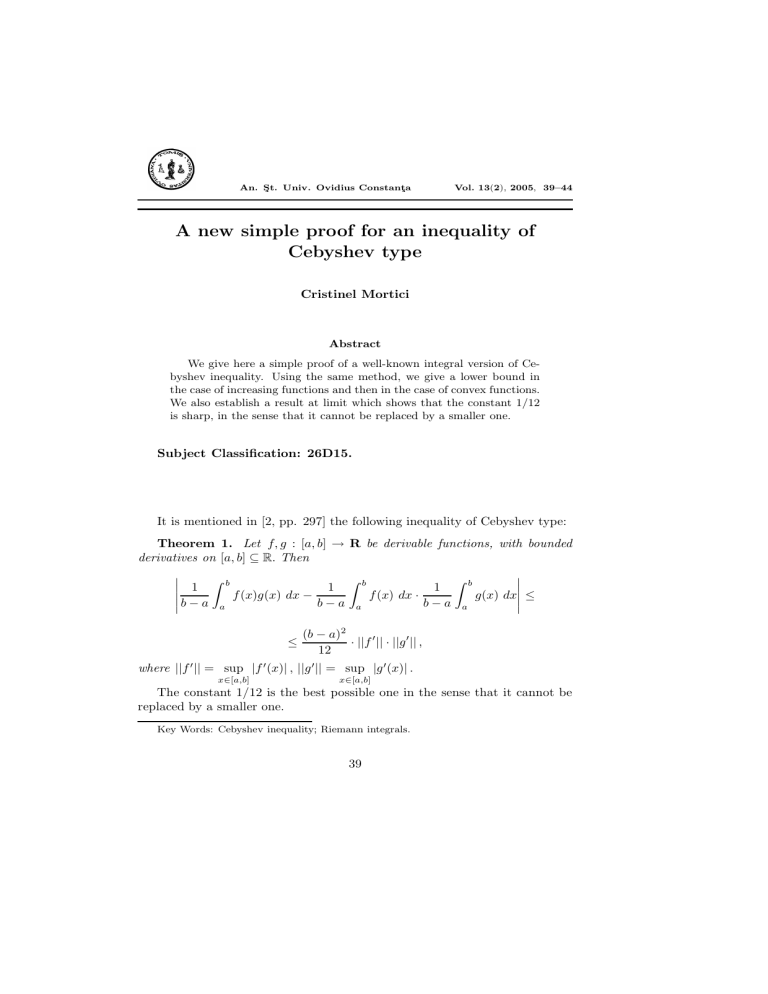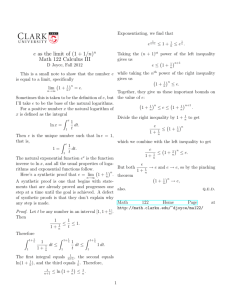A new simple proof for an inequality of Cebyshev type Cristinel Mortici
advertisement

An. Şt. Univ. Ovidius Constanţa Vol. 13(2), 2005, 39–44 A new simple proof for an inequality of Cebyshev type Cristinel Mortici Abstract We give here a simple proof of a well-known integral version of Cebyshev inequality. Using the same method, we give a lower bound in the case of increasing functions and then in the case of convex functions. We also establish a result at limit which shows that the constant 1/12 is sharp, in the sense that it cannot be replaced by a smaller one. Subject Classification: 26D15. It is mentioned in [2, pp. 297] the following inequality of Cebyshev type: Theorem 1. Let f, g : [a, b] → R be derivable functions, with bounded derivatives on [a, b] ⊆ R. Then b b 1 b 1 1 f (x)g(x) dx − f (x) dx · g(x) dx ≤ b − a a b−a a b−a a ≤ (b − a)2 · ||f || · ||g || , 12 where ||f || = sup |f (x)| , ||g || = sup |g (x)| . x∈[a,b] x∈[a,b] The constant 1/12 is the best possible one in the sense that it cannot be replaced by a smaller one. Key Words: Cebyshev inequality; Riemann integrals. 39 Cristinel Mortici 40 In order to prove the inequality, we denote t t t φ(t) = (t − a) f (x)g(x) dx − f (x) dx · g(x) dx a a , a t ∈ [a, b] . As we will see, the function φ plays a key role in what follows. We have t t t φ (t) = f (x)g(x) dx + (t − a)f (t)g(t) − f (t) g(x) dx − g(t) f (x) dx a a a which can be written as φ (t) = t a [f (t) − f (x)] [g(t) − g(x)] dx. With Lagrange theorem, we have |f (t) − f (x)| ≤ ||f || (t − x) , |g(t) − g(x)| ≤ ||g || (t − x), t [f (t) − f (x)] [g(t) − g(x)] dx ≤ |φ (t)| = a t ≤ |f (t) − f (x)| · |g(t) − g(x)| dx ≤ so a ≤ ||f || · ||g || · a t (t − x)2 dx = (t − a)3 · ||f || · ||g || . 3 In consequence, |φ (t)| ≤ (t − a)3 · ||f || · ||g || 3 , ∀ t ∈ [a, b] . Now, b |φ(b)| = |φ(b) − φ(a)| = φ (t) dt ≤ a b b (b − a)4 (t − a)3 ≤ dt = · ||f || · ||g || . |φ (t)| dt ≤ ||f || · ||g || · 3 12 a a We obtain |φ(b)| ≤ or (b − a)4 · ||f || · ||g || 12 b b b f (x)g(x) dx − f (x) dx · g(x) dx ≤ (b − a) a a a A new simple proof 41 ≤ (b − a)4 · ||f || · ||g || 12 and the required inequality follows by dividing with (b − a)2 . It is well-known that a basic form of Cebyshev inequality asserts that 1 b−a a b 1 b−a f (x)g(x) dx − b a f (x) dx · 1 b−a b a g(x) dx ≥ 0, if f and g are monotone, with the same type of monotony. Moreover, we establish here the following stronger inequality: Theorem 2 Let f, g : [a, b] → R be monotonically increasing. Assume further that f and g are derivable such that there exist α = inf f (x) x∈[a,b] , β = inf g (x) x∈[a,b] where α, β are nonnegative real numbers. Then 1 b−a b a 1 f (x)g(x) dx − b−a b a 1 f (x) dx · b−a b a g(x) dx ≥ (b − a)2 · αβ. 12 Proof. With the previous notations, we have φ ≥ 0 with t φ (t) = [f (t) − f (x)] [g(t) − g(x)] dx. (1) a We use again Lagrange theorem to obtain |f (t) − f (x)| ≥ α(t − x) and then φ (t) ≥ αβ a t , |g(t) − g(x)| ≥ β(t − x) (t − x)2 dx = (t − a)3 · αβ. 3 By integrating with respect to t on [a, b], we deduce φ(b) ≥ (b − a)4 · αβ. 12 2 Finally, the required inequality follows by dividing with (b − a) . Let us assume for now that f and g are twice derivable and there exist α2 = inf f (x) x∈[a,b] , β2 = inf g (x), x∈[a,b] Cristinel Mortici 42 where α2 and β2 are nonnegative. According with the Taylor theorem, we have f (ξ) f (ξ) α2 (t − x)2 ≥ (t − x)2 ≥ (t − x)2 2 2 2 f (t) − f (x) = f (x)(t − x) + and g(t) − g(x) = g (x)(t − x) + g (ξ) g (η) β2 (t − x)2 ≥ (t − x)2 ≥ (t − x)2 . 2 2 2 If we substitute these estimations in (1), we derive α2 β2 t (t − a)5 · α2 β2 . (t − x)4 dx = φ (t) ≥ 4 20 a (2) We can give the following similar inequality for twice derivable functions: Theorem 3 Let f, g : [a, b] → R be twice derivable and monotonically increasing. Assume further that α2 = inf f (x) x∈[a,b] β2 = inf g (x) , x∈[a,b] where α2 , β2 are nonnegative real numbers. Then b b b 1 1 1 (b − a)4 · α2 β2 . f (x)g(x) dx − f (x) dx · g(x) dx ≥ b−a a b−a a b−a a 120 Proof. By integrating the inequality (2) with respect to t in [a, b], we deduce α2 β2 b (b − a)6 φ(b) ≥ · α2 β2 (t − a)5 dt = 20 a 120 2 and the required inequality follows by dividing with (b − a) . In the sequel we use a new method to show that the constant 1/12 is the best possible. Normally, this it proved if we can find a particular case when the equality arise. To give an example, let us remark that f (x) = g(x) = x in case a = 0, b = 1 provide: 1 2 x dx − 0 0 1 x dx · 1 x dx = 0 1 1 1 − = . 3 4 12 A new simple proof 43 We also can prove the sharpeness of the constant 1/12 by giving the following Theorem 3 Let f, g : [a, b] → R be derivable, with continuous derivatives at a. Then t t t 1 1 1 1 f (x)g(x) dx − f (x) dx · g(x) dx = lim t→a (t − a)2 t − a a t−a a t−a a = 1 · f (a)g (a). 12 Proof. The required limit can be written as lim t→a φ(t) . (t − a)4 In order to use l’Hospital rule, let us compute t 1 φ (t) a [f (t) − f (x)] [g(t) − g(x)] dx lim = = lim t→a 4(t − a)3 4 t→a (t − a)3 t 1 f (ξt,x )g (ηt,x ) a (t − x)2 dx (t − a)3 1 1 = lim = · f (a)g (a) lim 3 = 3 t→a (t − a)3 4 t→a (t − a) 4 = 1 · f (a)g (a). 12 References [1] S.S. Dragomir, I. Fedotov, An Inequality of Grũss Type for Riemann-Stieltjes Integral and Applications for Special Means, RGMIA Research Report Collection, vol. I, No. 1, 89-95, 1998. [2] D.S. Mitrinović, J.E. Pecarić, A.M. Fink, Classical and New Inequalities in Analysis, Kluwer Academic Publishers, Dordrecht, 1993. Valahia University of Targoviste, Department of Mathematics, Bd. Unirii 18, Targoviste, Romania e-mail: cmortici@valahia.ro 44 Cristinel Mortici







